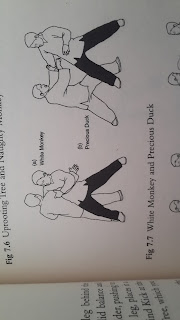Kungfu Moves in Karate. Move 2: Precious Duck Swims Through Lotus
Hi, everyone!
Welcome to the third installment in my series of posts about Kungfu moves found in Karate.
Read articles on the internet and you'll find that almost everyone says that Karate is developed from the White Crane style of Fujian. That is really an oversimplification of things.
I have never learnt White Crane. We at Martial Arts Forums have seen one video being posted in our group of an elderly master performing a White Crane form and I think we can all agree that it certainly does not resemble much of what we see in Karate today.
Today's technique, however, I have found in two styles of Karate before I have learnt about it in Shaolin Kungfu.
The move is called "Precious Duck Swims Through Lotus".
In Master Wong Kiew Kit's Five Animal Set this movement looks like this:
In Shukokai's- and Shito Ryu's version of the kata "Rohei" we find it looking like this:
The Precious Duck is the punch and not the block that preceeds it. That particular type of block I will discuss in another post.
In Shotokan's version of Jion we find the same type of punch used at the end like the above video is showing.
My apologies for this one. Simply rotating it does not seem to do the trick...
Where the punch starts of from a square-on position it uses hip rotation to shoot it into its target, reaching as far as possible by rotating the body and also making the target area facing the opponent much smaller. One can imagine how a maneuver like this can create space for you in a clinch situation.
Although Karateka have kept this movement in their katas they now use Oi Zuki to lunge into attack with a punch. The Zenkutsu Dachi (Forward Stance) used in Oi Zuki increases the reach while the body faces the opponent square-on.
My first Sensei explained that Karate people prefer not to punch in the Precious Duck- manner because a lot of leverage gets lost once the shoulder stretches out too far. To be honest I still don't get that. Having studied grappling, however, has made me aware that your Jujutsu, Judo and Aikido people love it when your shoulder is stretched out towards them like that. That is practically begging to be put in an arm bar...
The "Shomen" or square facing posture with punching makes the execution of grappling moves relatively more difficult, particularly the ones that involve seizing your arm and pulling you into the technique.
Where both Karate and Kungfu people agree, however, is that punching is a lot more powerful with the hip rotation. This move may be a lead hand punch, but the hip rotation lends it the power of a reverse punch.
I have not yet seen any movement resembling Karate's Oi Zuki in Shaolin Kungfu. It may be there somewhere, but I have not yet found it. In the Five Animal Set the Precious Duck is as close to Oi Zuki as you can get.
It is necessary to bear in mind that the Okinawan fighting arts did not lack any fighting techniques before the Chinese showed up. They actually already had a system of kicking, punching and grappling in place. Getting unusual techniques that your rivals have not yet seen is a very attractive idea to martial artists, however, and the martial artists on the Ryukyu Islands were not any different in that respect. We do see, however, that a lot of techniques got modified when they got taken over or just got replaced with techniques that were more familiar to the Ryukyu people.
A similar process happened again when Karate landed in Japan. I think anyone who has done a bit of research on Karate will agree that there is a world of difference between Shotokan and Goju Ryu.
That's it for today.
Enjoy the weekend and best of luck for the week ahead.






Comments
Post a Comment